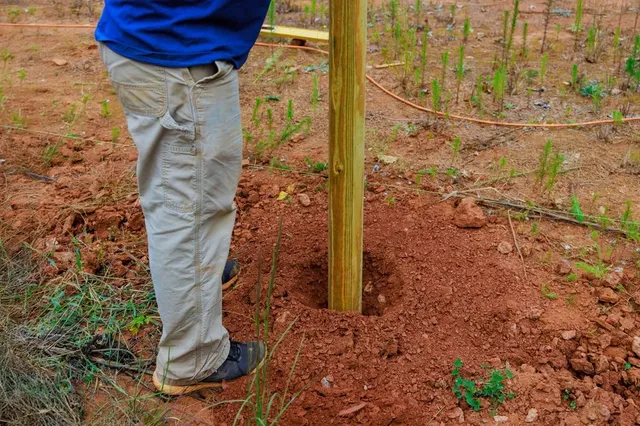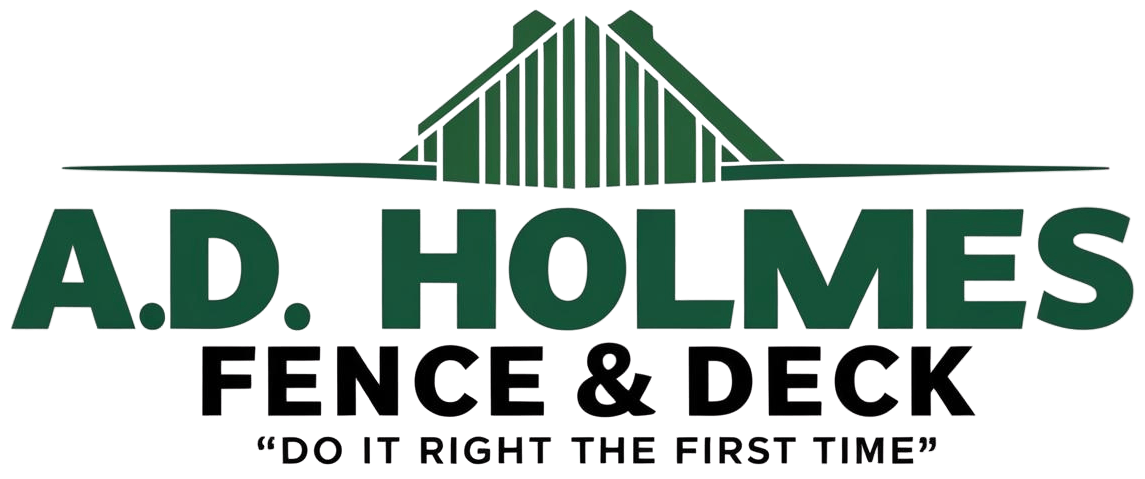
Fence Posts – Length, Depth & More
Installing fence posts correctly is the foundation of any successful fencing project. Whether you’re building a privacy fence around your Newmarket home or setting up a secure perimeter in Aurora, understanding proper post installation techniques can mean the difference between a fence that lasts decades and one that fails after just a few years. At A.D. Holmes Fence & Deck, we’ve been building durable fences throughout the York and Durham regions for over two decades, and we’ve learned that getting the posts right is absolutely critical.
Understanding Post Depth Requirements
The fundamental rule for fence post depth is surprisingly straightforward: posts should be buried to a depth equal to one-third of their total height, plus an additional 6 inches for a gravel base. For example, if you’re installing an 8-foot post for a 6-foot fence, you’ll need to dig approximately 32 inches deep (one-third of 8 feet equals 32 inches).
However, Ontario’s challenging climate adds an important consideration – the frost line. In the Greater Toronto Area, including our service areas of Markham, Whitby, and surrounding communities, the frost line typically extends 3 to 4 feet deep. This means your fence posts must be set at least 4 feet deep to prevent frost heave, which occurs when freezing and thawing cycles cause the ground to shift and potentially push your posts out of alignment.
The consequences of insufficient depth are significant. Posts that aren’t buried deep enough can lean, shift, or even come completely out of the ground during harsh winter conditions or severe weather events. This is particularly problematic in areas with clay soil, which expands and contracts dramatically with moisture changes.
Choosing the Right Post Size
Post sizing depends on several critical factors: fence height, material type, wind exposure, and the role the post plays in your fence system. For most residential applications, 4×4 pressure-treated posts work well for standard 6-foot privacy fences. However, corner posts, gate posts, and end posts typically require larger dimensions due to the additional stress they bear.
Standard Residential Posts
For typical line posts (the posts that run along straight sections of fence), 4×4 pressure-treated posts measuring 8 to 10 feet in length provide adequate support. These posts should be spaced 6 to 8 feet apart on flat terrain. In areas with challenging conditions such as slopes, high winds, or heavy snow loads, consider reducing spacing to 4 to 6 feet for added stability.
Terminal Posts Require Extra Strength
Corner posts, end posts, and gate posts experience significantly more stress than line posts and require special attention. For these critical positions, 6×6 posts are often the better choice, providing the extra strength needed to resist the pulling forces of fence sections meeting at angles or supporting gate hardware.
Gate posts deserve particular consideration based on gate width. Gates between 3 and 6 feet wide can typically be supported by properly installed 4×4 posts, while wider gates of 8 to 10 feet require 6×6 posts to prevent sagging and ensure smooth operation over time.
Selecting Quality Materials
Not all pressure-treated posts are created equal. Look for posts specifically rated for “ground contact” use, which indicates they’ve been treated to handle direct soil contact and moisture exposure. The most common treatment in Canada is CCA (Chromated Copper Arsenate), which provides excellent protection against rot and insect damage.
Cedar posts offer a naturally rot-resistant alternative, though they typically cost more than pressure-treated options. Western red cedar and white cedar both provide excellent longevity in ground contact applications. Regardless of material choice, ensure all posts are properly seasoned and dry before installation to minimize future warping and splitting.
The Critical Importance of Proper Anchoring
Simply burying a post in soil isn’t sufficient for long-term stability. Proper anchoring techniques are essential for creating a fence that withstands Ontario’s challenging weather conditions.
The Three-Layer Foundation System
The most effective anchoring method uses a three-layer approach. Begin by adding 4 to 6 inches of crushed gravel at the bottom of each post hole. This drainage layer prevents water accumulation around the post base, significantly reducing the risk of rot. Compact this gravel layer thoroughly using a tamping bar.
Next, position your post in the hole and ensure it’s perfectly plumb using a level. This step cannot be rushed – a post that’s even slightly off-plumb will create alignment issues that become magnified across the entire fence line.
Finally, backfill around the post using either concrete mix or compacted soil, depending on your specific requirements and soil conditions. Many professional installers prefer a combination approach: concrete for the bottom two-thirds of the hole for stability, topped with compacted soil that slopes away from the post to shed water.
Concrete vs. Alternative Anchoring Methods
Concrete provides maximum stability and is particularly important for gate posts and corner posts that experience high stress. Use a fast-setting concrete mix designed specifically for fence posts, which typically sets in 20 to 40 minutes. For a standard 4×4 post, two 50-pound bags of concrete mix are usually sufficient.
However, concrete isn’t always the best choice. In areas with very clay-heavy soil or high water tables, concrete can actually trap moisture around the post, accelerating rot. In these situations, consider using compacted gravel backfill instead, which provides good stability while allowing for drainage.
For ultimate rot protection, consider using post-saving sleeves or wraps that create a moisture barrier around the critical ground-line area where most rot occurs. These products can extend post life by decades and are particularly valuable for expensive cedar or specialty posts.
Special Considerations for Different Fence Types
Different fencing materials create unique demands on post installation. Wood fences require posts that can handle the weight of solid panels and wind loading, while chain-link installations need posts capable of maintaining proper tension across long spans.
Chain-link fence posts are typically spaced closer together, at 3-meter (10-foot) intervals, as specified by Canadian standards. The posts must be perfectly vertical to maintain proper fabric alignment and tension. Terminal posts in chain-link applications require concrete footings that extend below the frost line, with depths typically 300mm (12 inches) deeper than line posts.
For privacy fences and decorative installations, wind loading becomes a primary concern. Solid fence panels act like sails in high winds, creating significant stress on posts. In exposed locations or areas known for strong winds, consider increasing post size or reducing spacing to handle these forces effectively.
Managing Challenging Installation Conditions
Ontario’s diverse soil conditions present unique challenges for fence post installation. Clay soils, while providing excellent holding power once posts are set, can be difficult to dig and may require special techniques to prevent water accumulation.
In rocky soil conditions, you may need to adjust post placement slightly or use specialized drilling equipment. Never compromise on depth requirements due to difficult digging – instead, consider alternative locations or professional installation assistance.
Areas with high water tables or consistently wet soil require additional drainage considerations. Installing French drains or extending gravel bases can help manage moisture issues. In extreme cases, consider above-ground anchoring systems that eliminate direct soil contact entirely.
Seasonal Installation Considerations
Timing your fence installation can significantly impact success. Spring and fall typically offer the best conditions, with moderate temperatures and manageable soil conditions. Avoid installing during frozen ground conditions, as proper excavation becomes impossible and concrete curing is compromised.
Summer installations require attention to concrete curing conditions. Hot, dry weather can cause rapid moisture loss, leading to weak concrete. Use cold water for mixing and consider misting or covering fresh concrete to ensure proper hydration.
Winter installations, while challenging, are possible with proper preparation. Ground may need to be thawed using heaters, and concrete additives designed for cold weather applications become essential.
Maintenance and Long-Term Care
Even properly installed posts benefit from regular maintenance. Annual inspections should focus on the ground line area where most problems develop. Look for signs of rot, insect damage, or shifting that might indicate foundation problems.
Water management around posts is crucial for longevity. Ensure drainage slopes away from posts and remove any debris or vegetation that might trap moisture. Consider applying wood preservatives or sealers to above-ground portions of posts every few years to maintain protection.
For comprehensive guidance on maintaining different fence types, explore our fence maintenance resources for specific care instructions tailored to your installation.
Professional Installation Benefits
While fence post installation might seem straightforward, the expertise required for consistently excellent results shouldn’t be underestimated. Professional installers bring specialized equipment, extensive experience with local soil conditions, and knowledge of regional building codes and requirements.
At A.D. Holmes Fence & Deck, we’ve encountered virtually every installation challenge possible across our service areas from Stouffville to Oshawa. Our experience allows us to anticipate problems, select appropriate techniques for specific conditions, and ensure installations that provide decades of reliable service.
Professional installation also ensures compliance with local regulations and HOA requirements, protecting your investment and avoiding potential legal issues. Many municipalities have specific requirements for fence construction that DIY installers might overlook.
Conclusion
Proper fence post installation forms the foundation of any successful fencing project. By understanding depth requirements, selecting appropriate materials, using correct anchoring techniques, and considering local conditions, you can ensure your fence provides years of reliable service. Whether you’re planning a DIY project or considering professional installation, these fundamentals will guide you toward a successful outcome.
The investment in proper post installation pays dividends in fence longevity, reduced maintenance requirements, and continued property value enhancement. For homeowners across the York and Durham regions considering a new fence project, remember that the posts you can’t see are just as important as the beautiful fence sections visible above ground.
For expert guidance on your specific fencing project or to learn more about our installation services throughout Newmarket, Aurora, Markham, and beyond, we recommend consulting with the Canadian Fence Industry Association (https://www.canadianfenceassociation.ca/), which provides valuable resources on industry standards and best practices for fence construction across Canada.




